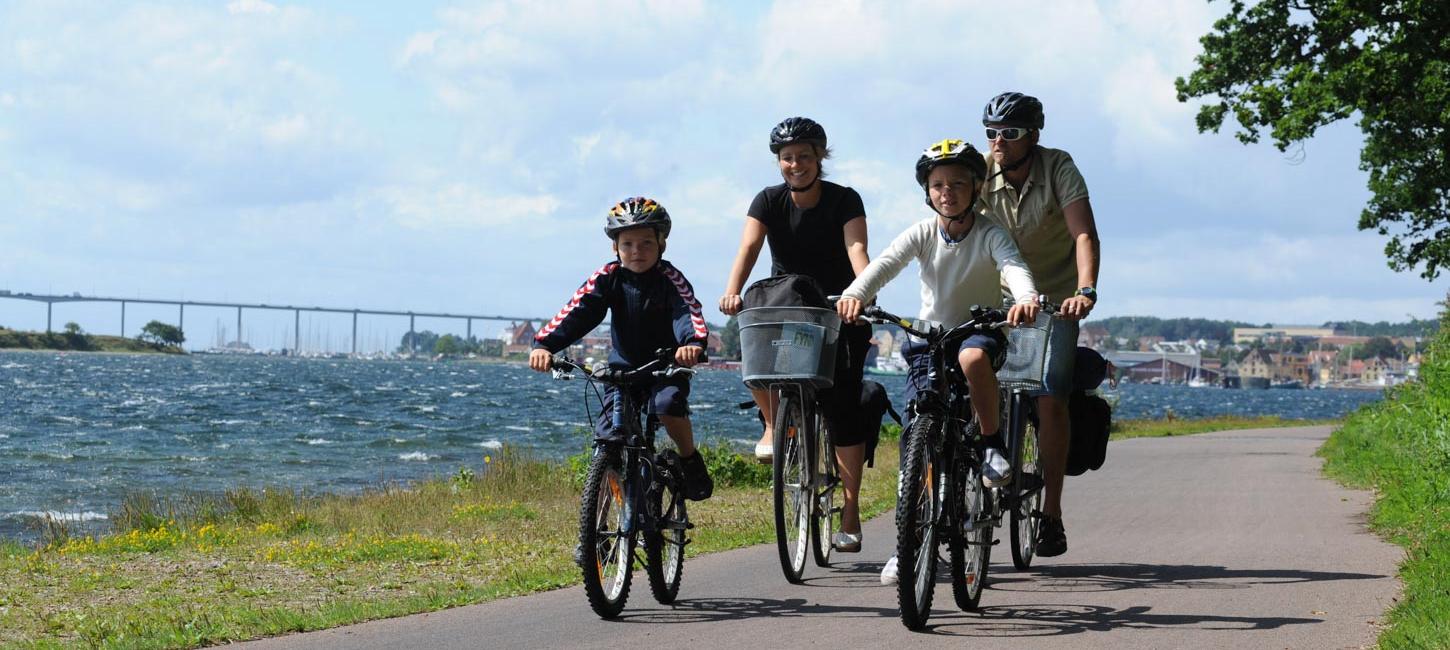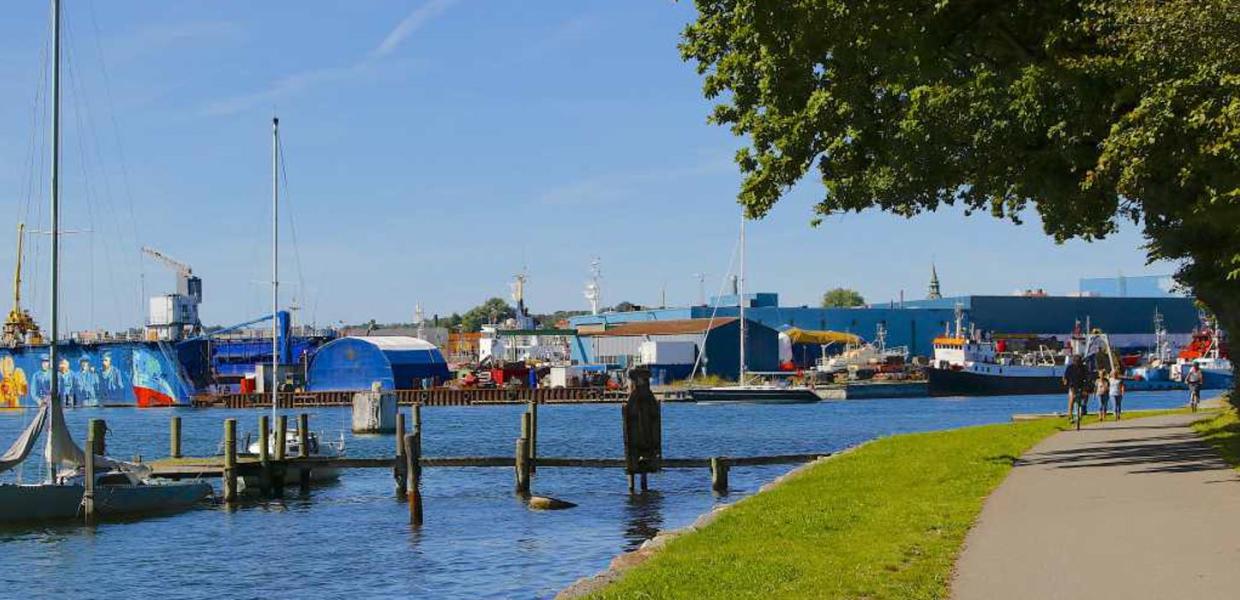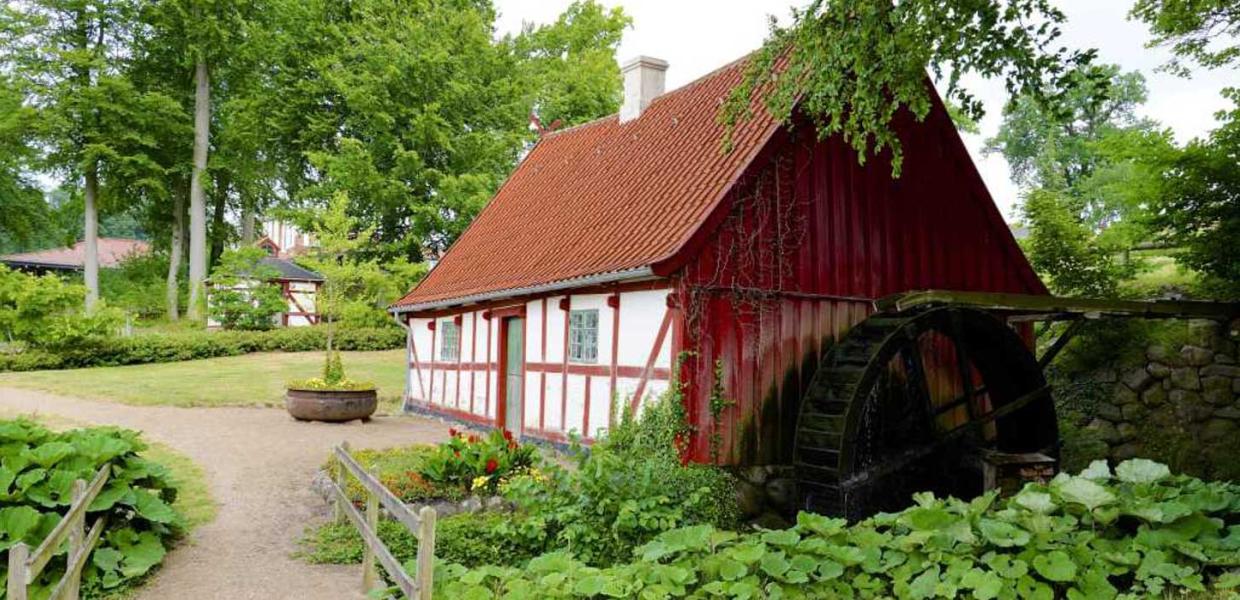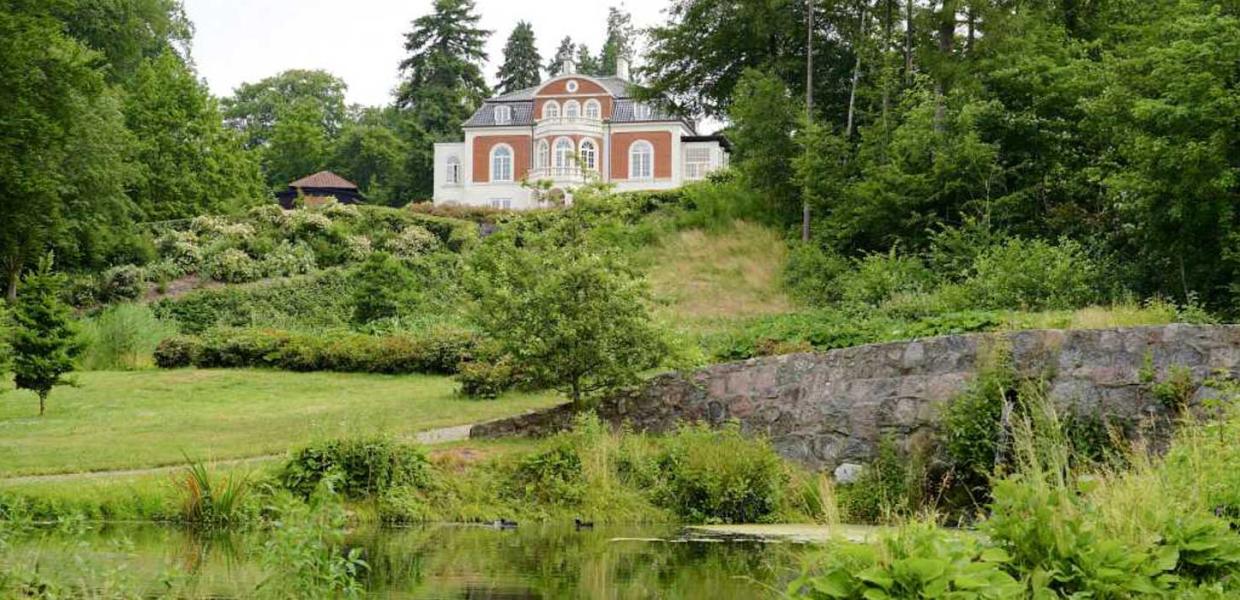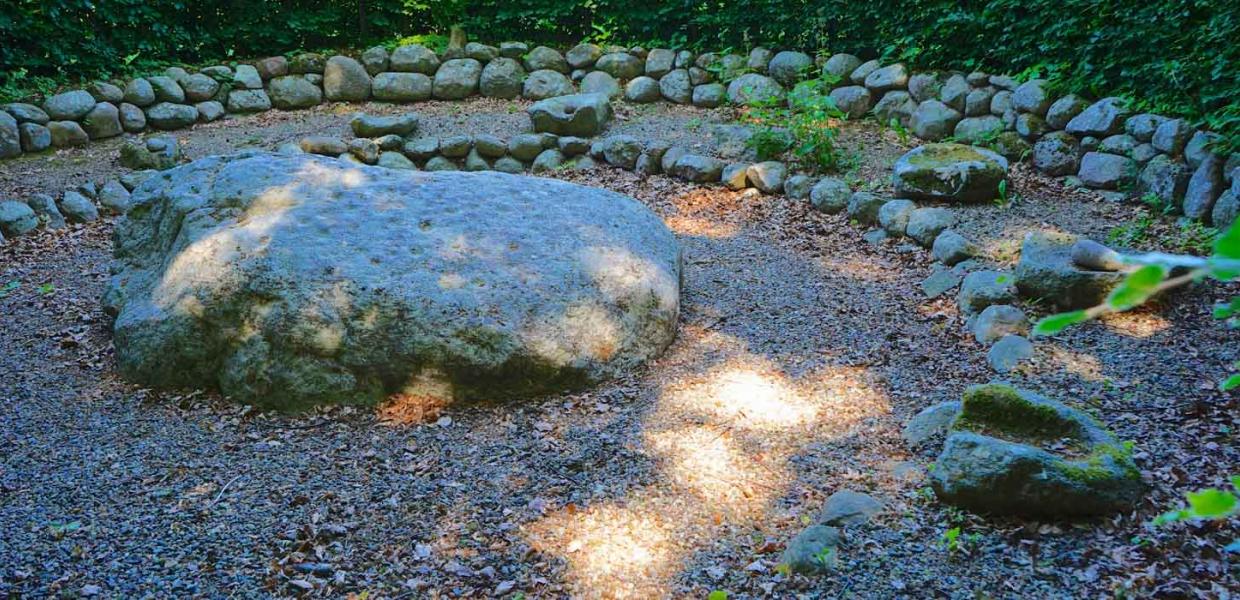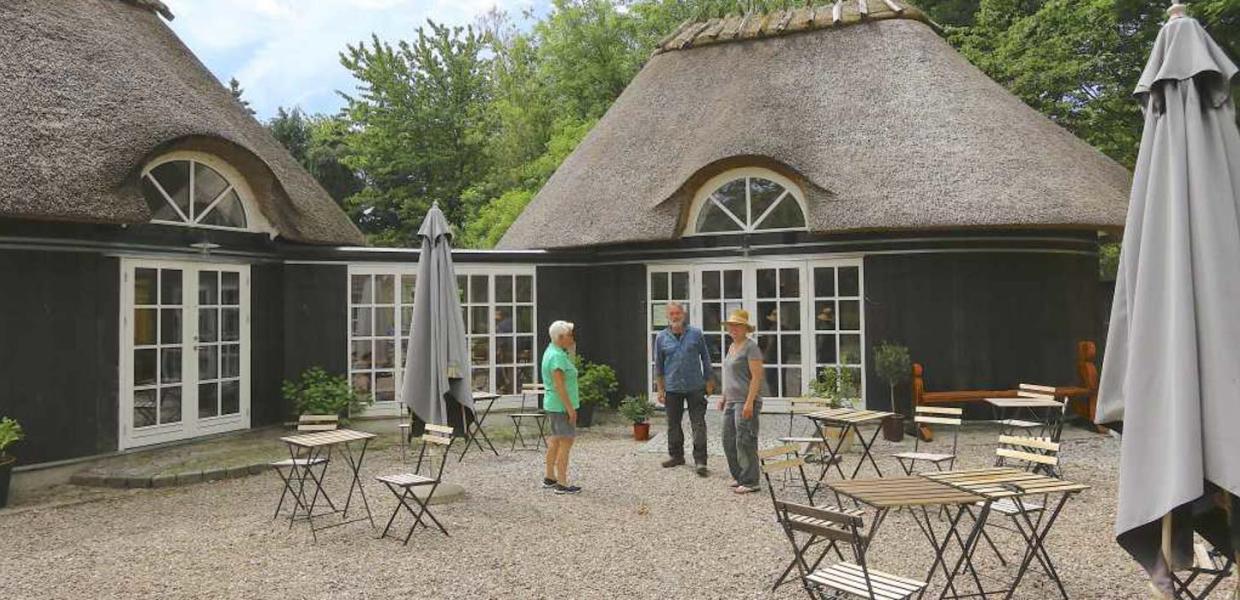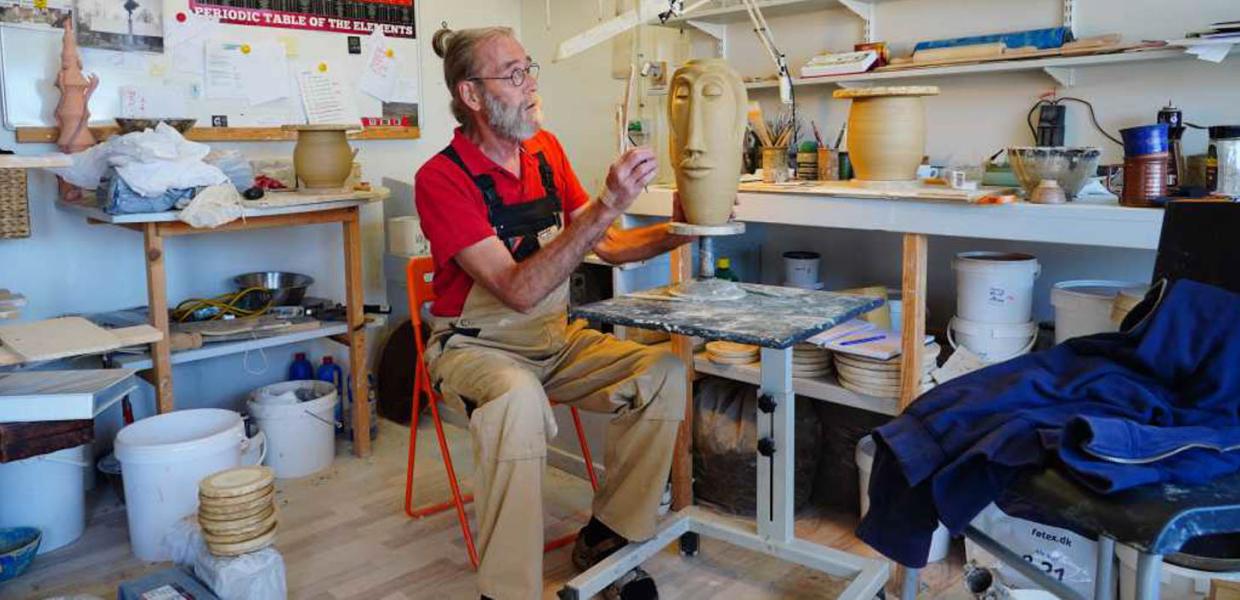Cycle route: Svendborg – Lundeborg
VisitFyn invited the experienced travel journalist Johnni Balslev to come along on a cycle ride between Svendborg and Lundeborg. A route offering great experiences such as beaches, fruit orchards, whisky, wine, and rolling landscapes.
Before setting off
This is a route you can easily ride on a standard bicycle, although ideally one with seven gears. An electric bike will make things even easier in the hilly landscape.
Fri BikeShop is the biggest bike store in Svendborg and can deliver modern rental bikes at short notice. Svendborg Cykeludlejning on the little island of Frederiksø can also supply cycles. The standard bicycles provided here are renovated cycles from the “Cykelttutten” integration project that is based opposite the store. Several of the hotels in town also have cycles for their guests to use – or can arrange cycle hire.
Call in at VisitSvendborg for information about accommodation and activities.
The majority of the cycle route from Svendborg to Lundeborg follows the course of the Baltic Sea Route (National Route 8), which is signposted clearly.
The trip
Route:
In Svendborg, the cycle route to Lundeborg starts by following a stretch of Jessens Mole (pier) before continuing along Nordre Havnevej. We cut across the corner of the harbour area, riding down Nordre and Østre Kajgade to the waterfront, and on to Østre Havnevej, before taking Route 8 (the Baltic Sea Route) past Christiansminde.
Information:
The rough, masculine industrial environment that permeates the quays in Svendborg Harbour is in stark contrast to the soft and gentle landscape we encounter on the remainder of the ride.
Only a few Danish market towns can boast a high level of commercial activity, but Svendborg still welcomes coasters, which tie up under the giant grain silos. Across the harbour, the J. Ring-Andersen Shipyard is abuzz with activity. The yard is best known for its work to preserve old schooners and small vessels that sail the inner coastal waters. The business next door – Gnisten-Thurøbund Marine – runs two large dry docks in partnership with Petersen & Sørensen Motorværksted, where they maintain and repair larger vessels. Otherwise, the small island of Frederiksø opposite the grain silos has found a new lease of life as an active cultural area liberally sprinkled with cafés, exhibitions and galleries, a mini-golf course and the Danish Yachting Museum.
A large section of the harbour in the north-western corner is soon to be converted into a new training facility for Danish maritime officers. Today, the Svendborg International Maritime Academy (SIMAC) is located a little way outside the harbour, but an architects’ competition is being held with a view to moving the institution closer to the water, where 900 students will soon be able to train as master mariners or marine engineers.
Svendborg Shipping College (Svendborg Søfartsskole) and SIMAC both have their teaching vessels moored at the end of the quay. A large rescue boat is also to be found here and is used to help students practice dealing with emergency situations.
At the point where the route joins Østre Havnevej, the global cereal company Kellogg’s once had a giant production factory. It was closed at almost the same time as Svendborg Shipyard pulled down the shutters for the last time, around the turn of the millennium. These two closures saw Svendborg losing two major workplaces that provided jobs for hundreds of people.
In the unlikely event that the large gates are closed, shutting off the quay, you can join Østre Havnevej to the left of the gates. This only usually happens if there is a lot of activity on the quay when ships are being loaded or unloaded.
Photo:Johnni Balslev
Route:
The trail to Christiansminde turns to the right from Østre Havnevej, following the contours of Svendborg Sound. Signposts marked “Østersøruten (8)” show the way.
Information:
After passing Svendborg Rowing Club, we are treated to a truly beautiful view out over the waters of Svendborg Sound to the island of Tåsinge. Svendborg Sound is still sailed by large coasters and enchanting wooden sailing ships. On the left-hand side stands Hotel Christiansminde.
The hotel is currently in the midst of an exciting conversion process. Originally built as a hotel in 1977, it was taken over by the Danish trade union HK for use as a course centre in 1981 and it is now run on more normal market terms. There are delightful views from the hotel restaurant and terrace. You can book a stay here and enjoy a variety of activities on land and in the water – the hotel is particularly keen on cycling activities.
Just down from the hotel is the boarding pier for the good ship Helge. Helge is an elderly lady. Er ... a man, surely? What’s wrong with this picture? Ships are always female, or what? The explanation is lost in the mists of time, but what is certain is that the ship was built in Svendborg in 1924, and sailed regular routes around the Archipelago all year round until 1954. Today, Helge sails in the period May–September. Its route starts in Svendborg and calls at Vindebyøre Camping on Tåsinge and then visits Christiansminde, Troense and Grasten on Thurø before arriving at its final port of call: Valdemars Slot (Castle) on Tåsinge. The full trip takes around 1 hour and beer and soft drinks are on sale on board. There is limited space on the vessel for cycles and prams/pushchairs.
Photo:Johnni Balslev
Our cycle route turns slightly inland by the old watermill to the left, after passing through a popular area where there are facilities to barbecue and eat under a long pent roof. Christiansminde Strand (beach) now appears on our right-hand side. There is a large-ish shop and grill bar here, with a mini-golf course and a playground behind the building. There are toilets on both sides of the trail.
Shortly afterwards, we ride into a small grove where the undergrowth is sprinkled with ramson plants in the early spring. On the other side of the grove stand three Weber buildings, clearly inspired by the Italian style of architecture. These impressive buildings previously belonged to the Weber family, which primarily earned its fortune as a plantation owner and winemaker. The family owned around 40 hectares of land, which they mainly used to grow apples, as well as blackcurrants and cherries. Theobald Christian Frederik Weber arrived here from Copenhagen in 1866. He and his wife Sophie Emilie Meldola had ten children, so they soon needed more space.
An elongated building can be seen at the back end of the lawn. This was once part of an eatery built by the Weber family.
Photo:Johnni Balslev
Route:
The trail soon becomes the residential road Myrehøjvej, which it follows until it joins Hestehavevej.
Here, we turn left onto the two-way cycle path and do not have to cross the road.
Detour:
The road to the right leads to the island of Thurø with its protected reef, woods, attractive paths, and Smørmøsen, the best bathing beach on South Fyn. Other attractions include possibly the most entertaining mini-golf course in Denmark and the Ø-bryg brewery, which is located next to Thurøstuen restaurant (open all year), where you can meet the locals and enjoy a delicious meal.
Route:
Just before the roundabout, we turn right and cross to the other side. We then continue along Linkenkærsvej, which is the second exit from the roundabout.
Detour:
The first exit from the roundabout leads to Skårupøre and Åbyskov, and the road passes Svendborg Media and Sports College just a few hundred metres farther along. By the driveway to the college, there is an extremely interesting sight on the left, well-hidden behind a circular hedge.
Photo:Johnni Balslev
The Æbleskivestenen (“Pancake Puff” stone) as it is known is a sacrificial stone from the Bronze Age and features 105 bowl marks. The main stone is surrounded by 13 mill stones, and the whole setting was preserved at the request of the Weber family. In Denmark, the Bronze Age lasted from 1800 to 500 BC.
Route:
We now turn onto the old railway line, signposted as “Østersøruten” (the Baltic Sea Route).
Information:
This is the route of the train service that operated between Svendborg and Nyborg from 1897 until 1964. To the right, you can just make out the long buildings constructed by the Danish trade union SID as a course centre in 1977, and which are now home to Svendborg Media and Sports College (previously Rantzausminde College).
Farther to the left is a wide open area featuring a large number of visible Iron Age burial mounds. As many as 23 have been found here, along with the remains of two settlements. Today, it is a popular place for walking dogs.
Route:
Where the trail crosses Huusomvej, we continue straight ahead and cross Huusomvej to reach the Aqua Vitae distillery and Skårupøre Vingaard (winery), where there is a truly breath-taking view from the heady heights of the South Fyn hills.
The railway path then crosses Egenappevej and becomes a standard track, which we follow all the way to Holmdrup Huse, where the route passes a large stud farm and riding school to the right.
At the T-junction, we turn right towards Holmdrup Huse. The road climbs slightly to Skovmøllevej, where we turn left and continue on up to the busy Nyborgvej. Here, we cross the road, turning right onto the two-way cycle path. Fortunately, we only have to follow the busy road for a short distance.
A few hundred metres further on, we turn right down Skårupørevej (Signposted: Destilleri og Vingård (Distillery and Winery)). It is the first road on the right-hand side.
Information:
Here, at an elevation of 50 metres, there are two “sweet shops” for adults.
Aqua Vitae Sydfyn (The Little Distillery), Skårupørevej 22, Lene True +45 61 36 81 83 or Karsten Kjer Michaelsen +45 21 34 21 67.
The “Spirit Factory” doesn’t look like much from the outside, but on the inside there is an attractive shop and a large room that can easily accommodate a coach-load of visitors. Lene is pretty much always there, and Karsten needs little encouragement to talk humorously about the noble art of distilling. The apple-based aperitif Pomó is most definitely worth a taste.
We then continue on down the road to meet Lene’s and Karsten’s neighbours Bente and Carsten.
Skårupøre Vingaard, Skårupørevej 28, Bente Rasmussen and Carsten Andersen, +45 61 26 03 68 or +45 61 26 05 68.
Bente and Carsten have waved goodbye to their careers in social psychiatry and devoted themselves to their small winery with its café and shop which are housed in two giant “wine barrels” with thatched roofs. They are happy to talk about all the intricacies of wine-making. They primarily produce sparkling wines here, and the entire area is a delightful oasis right next to their romantic timber-framed home.
Photo:Johnni Balslev
The route:
Having visited these two attractions, we push on along Skårupørevej, taking care not to pick up too much speed on the downhill section – even though it may be tempting. The reason for this is that halfway down the hill we have to turn left along Ulkens Dal (valley), where we have the chance to admire the wonderful views out over the water to the island of Langeland.
At the end of Ulkens Dal, we turn right onto Åbyskovvej and head on down towards the water. The road curves gently to the right in Åbyskov, where its name also changes to Skibsvej. We then turn left onto Strandvejen and pick up the Baltic Sea Route (Østersøruten) again towards Lundeborg.
Information:
Before long, the route takes us to the excellent DCU Åbyskov Strandcamping campsite, which has a small shop selling ice cream and refreshments. There are also good toilet facilities here.
We continue through a small grove, past fruit orchards on both sides of the road, and the out past Brohave holiday house area.
Shortly afterwards, the route passes the mouth of Vejstrup Å river on the right-hand side, by a small bridge. The river valley cannot be accessed here; however, there is an entry point a little farther along, on Nyborgvej in Vejstrup.
The road now turns sharply inland, skirting Tiselholt Estate which covers fully 215 hectares. Dismount at the bend in the road to have a look at the house down by the water’s edge of which Kirsten Gro Pedersen – the owner of Tiselholt – is understandably fond.
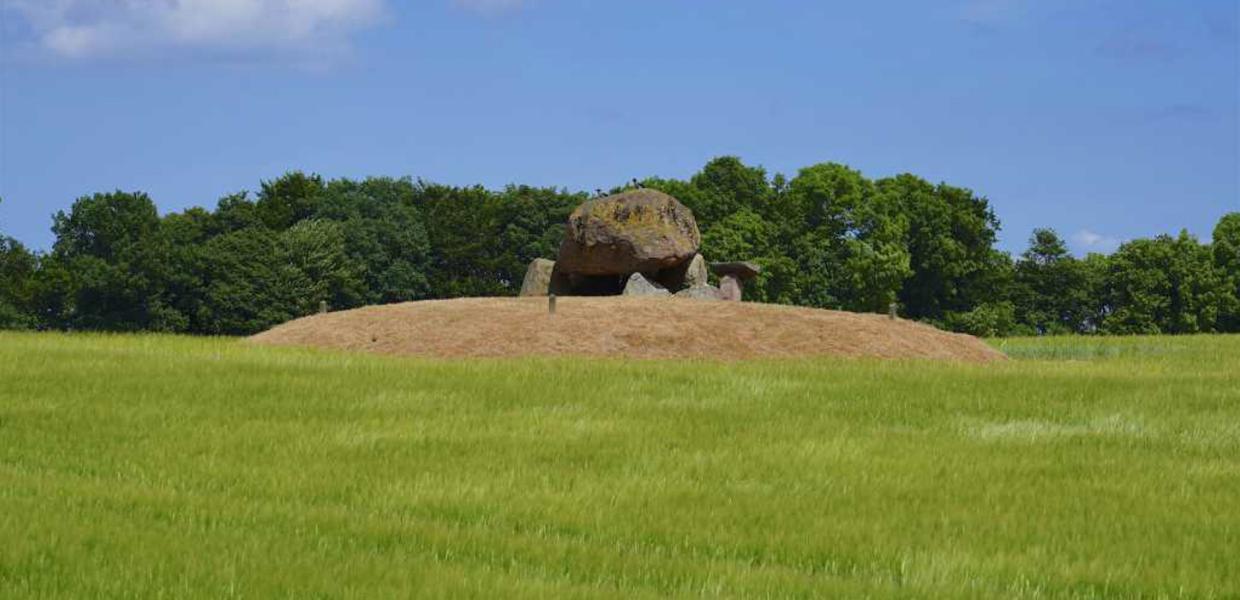
Photo:Johnni Balslev
The route:
The route runs uphill towards the first road – Maglehøjvej – on the right-hand side. Where Maglehøjvej comes to an end, we turn right for a short stretch along Tiselholtvej. We do not continue along the avenue towards Tiselholt, but turn left along Hovvej. At the first crossroads, we turn right onto Elsehovedvej.
Information:
It is not known for sure whether Elsehovedvej is one of the longest gravel tracks in Denmark, but before long the road turns to the right and becomes a gravel path after a charming area of woodland down by the water. Here, it turns inland again before continuing alongside a holiday house area and a small patch of woods which is the perfect place to take a dip in the shallow waters along the coast. There is also a public toilet by a large car park in the woods. The gravel track is almost 2 km long.
Detour:
Where Elsehovedvej ends at Tanghavevej, the official route actually continues along the other side down Fredskovvej, but I recommend taking a short detour up Tanghavevej to no. 43.
Information:
Mosgaard Whisky was founded in 2015 by Gitte and Jes Mosgaard. For opening hours, visit the website or call +45 24 80 93 02.
The beautiful “Mosgaard Whisky” distillery produces both gin and whisky. How about a gin made of rhubarb or citrus fruits? The whisky in the large barrels has to be left to mature until 2019, but you can taste and purchase single malt from small barrels.
The route:
Continues back along Fredskovvej opposite Elsehovedvej.
Information:
We pass Strandagergaard, set in delightful surroundings with decorative horses in the field in front of the water and Langeland, on our right-hand side.
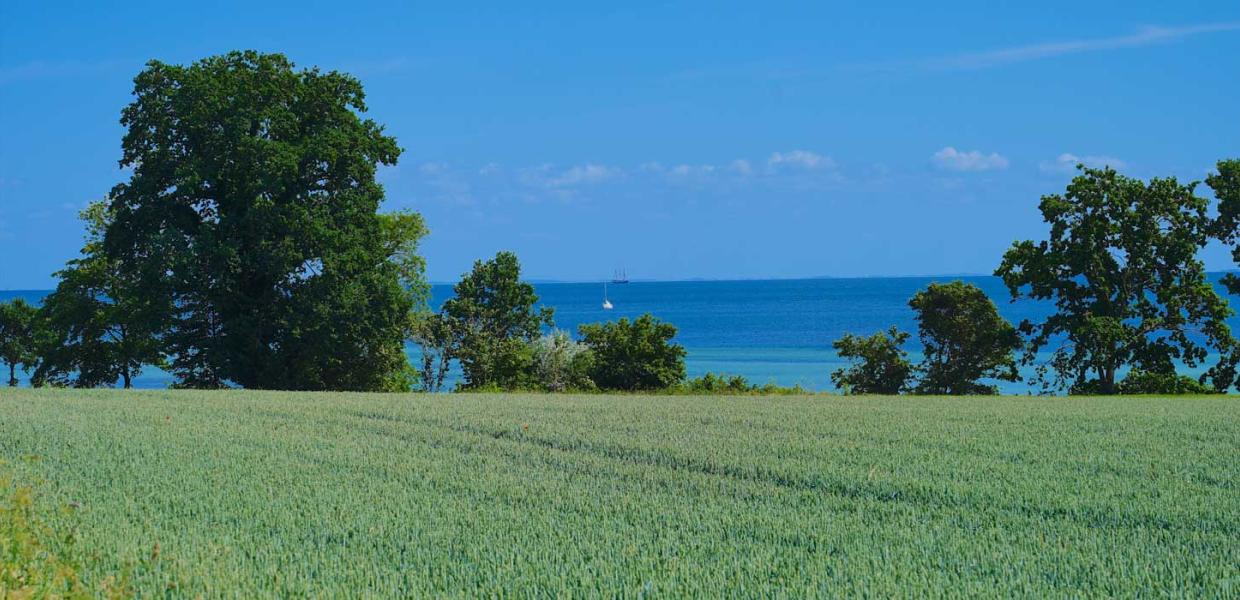
Photo:Johnni Balslev
The route:
Where Fredskovvej comes to an end, we turn right onto Knarreborg Møllevej. This road becomes Kystvej in Lundeborg.
Information:
Knarreborg Farm is immediately on the left, with the remains of the almost completely concealed old watermill on the opposite side of the road. Knarreborg is the main building of Knarreborg Mølle Camping which we come to immediately afterwards.
A little further on, Lundeborg Church indicates that we are approaching the end of our trip. The church, which dates back to 1917 is set in a beautiful location, close to the water and just south of Lundeborg.
Shortly after the church, we pass Caroline Amalievej on the left. This is where the well-known Danish singing couple Lasse and Mathilde have a farm.
Ove Bager, another well-known Danish songwriter, penned a “hymn” to Lundeborg, and just like Lasse and Mathilde’s hit Fyn er fin (Fyn is fine), it is a much-loved popular ballad. Ove Bager actually donated one of his gold discs to the fishermen of Lundeborg. It still adorns a wall somewhere in the harbour area.
The little fishing hamlet was originally established as a shipping point for Broholm Estate. Count Sehested, the owner of the estate, had a vain hope that Danes would move to Lundeborg rather than emigrating to America. He actually built an entire little town here in the period 1862–66, including a home for veterans from the 1864 war with Germany.
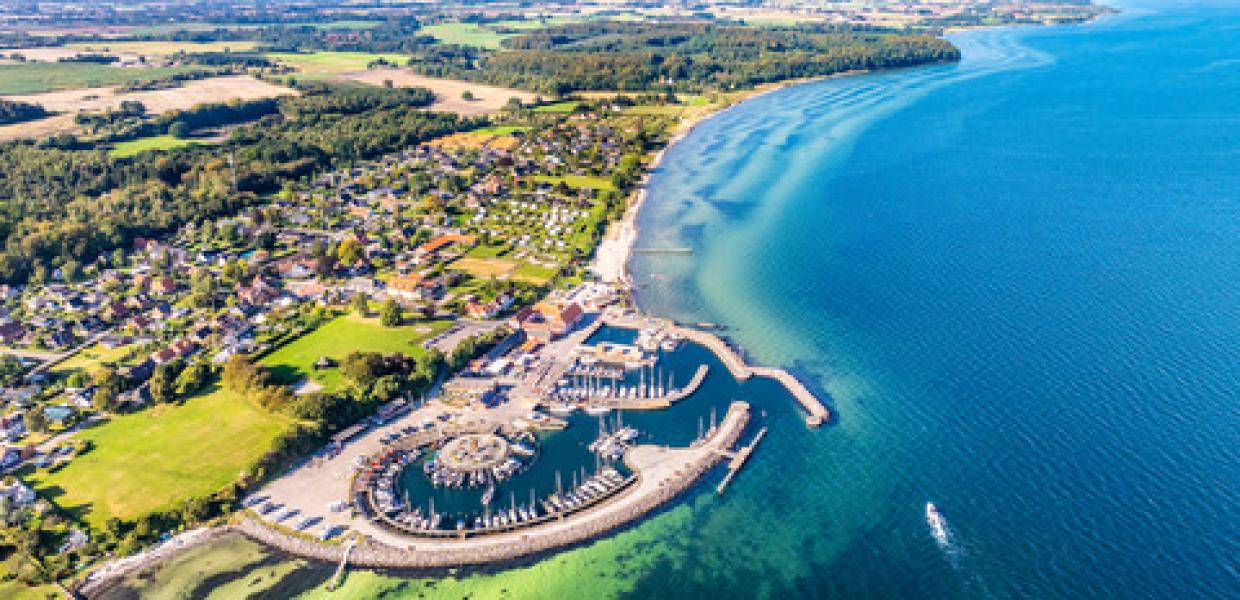
Photo:Aurélien Brusini
“There’s not a lot of fishing left in the harbour,” relates Dorthe Clausen, Harbour Master. “In fact, there’s just one fisherman who supplies fish to Jensens Fisk & Vin by the harbour.”
In contrast, it seems that Lundeborg is popular with the free-time fishermen, and a lot of leisure sailors also find their way to the new marina next to the industrial harbour.
There are several eateries dotted around the harbour area in Lundeborg. Aside from Jensens Fisk & Vin, there is the neighbouring establishment: Pakhusgården. This is a pop-up café which was previously housed in the attractive, newly renovated Packhouse on the harbour front. Another popular establishment is Lundeborg Is & Mad (Ice cream & Meals), which is located right next to the wonderful beach to the north of the harbour.
There is one campsite by the beach to the north of Lundeborg Harbour on Gl. Lundeborgvej. Lundeborg Ny Camping. If there is a little more “elastic” in your credit card, you can treat yourself to a truly luxurious stay at Broholm Slot, which is just 3.5 km from Lundeborg. It is a place with a peerless historical soul.
For opening hours, it is a good idea to check the local website lundeborginfo.dk. The site contains all kinds of useful information about life in and around Lundeborg. For example, what’s on in the large activity centre by the packhouse, or in Bazaren – Lundeborg’s local flea market? Or there may be an intimate concert in Smøjen at the Orange Scene behind the harbour, right next to the fishermen’s black-painted wooden huts … The site also presents information about the numerous work groups and committees to which the town’s 400 residents devote time and effort.
Potter Thorvald Brix Isager has a quaint studio and shop in the heart of the harbour area. His business is open all year round, but like most of the people in Lundeborg he enjoys taking a siesta in the middle of the day. This also applies to the two campsites near the town.
Photo:Johnni Balslev
Thorvald is a “newcomer”, but has settled in seamlessly. For example, he is president of a group that is working to open a local grocer staffed by volunteers. The problem of local shops closing in small communities is a hot topic in South Fyn. Dyreborg west of Fåborg and Troense on Tåsinge have already opened similar shops run by volunteers.
Thorvald loves the environment and the sense of community in Lundeborg.
“I’ve really found my niche here. One example of the community spirit is that we run a ‘Friday bar’ in local inn (Den gamle Krostue) every Friday – with a communal meal every second Friday. And in the summer we all meet up by the harbour, to talk about all kinds of issues, great and small,” says the tall potter with a smile.
This is where the Svendborg–Lundeborg ride drew to a close for journalist Johnni Balslev, but see below for ideas and inspiration about other things to see and do in the region.
